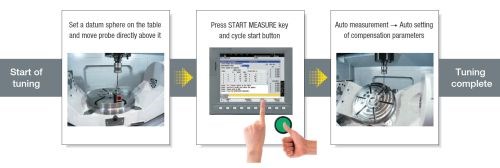5 to 10 for 5
An auto tuning option for Okuma five-axis machines is said to reduce tuning time for geometric errors from five hours to just 10 minutes.
Share







recently introduced its 5-Axis Auto Tuning System, which replaces the manual tuning process typically used to maintain motion accuracy of CNC machines. As the company points out, manual tuning, a typical practice in many machine shops to compensate for various geometric errors, can take five hours or more to perform. The 5-Axis Auto Tuning System performs measurements and compensation and enables adjustments to be made in 10 minutes, minimizing downtime and enabling higher levels of accuracy, the company says. Auto Tuning is currently available as an option on a variety of new Okuma five-axis machines, including the MU-V series.
During machining, kinematic errors can affect the quality of the finished part. Machines also come out of level over time, and even the smallest bumps can cause geometric errors. When these issues arise, it’s common for machine operators to perform kinematic tuning to compensate for the errors. Done manually, this is a painstaking process involving complex mathematical calculations and manual data entry, and is prone to some degree of human error.
With Okuma’s 5-axis Auto Tuning System these adjustments can be performed in approximately 10 minutes, depending on machine size. In addition to time savings, the 5-axis Auto Tuning System does not require a high level of skill to operate. It measures the machine and automatically compensates up to 13 geometric errors, including volumetric accuracy. This gives the end-user the ability to check and correct the machine whenever necessary, ensuring accuracy and productivity while minimizing downtime.
Auto Tuning is the fourth in Okuma’s “Intelligent Technologies” suite of performance-enhancing functionalities, which includes the Thermo-Friendly concept. Learn more about that in this article.
Related Content
-
How to Mitigate Chatter to Boost Machining Rates
There are usually better solutions to chatter than just reducing the feed rate. Through vibration analysis, the chatter problem can be solved, enabling much higher metal removal rates, better quality and longer tool life.
-
Quick-Change Tool Heads Reduce Setup on Swiss-Type Turning Centers
This new quick-change tooling system enables shops to get more production from their Swiss turning centers through reduced tool setup time and matches the performance of a solid tool.
-
The Future of High Feed Milling in Modern Manufacturing
Achieve higher metal removal rates and enhanced predictability with ISCAR’s advanced high-feed milling tools — optimized for today’s competitive global market.












